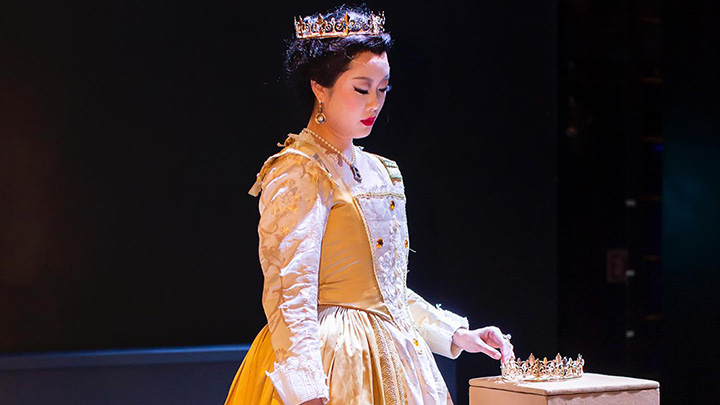
In 1829, Gaetano Donizetti dipped into Tudor history with Elisabetta al Castello di Kenilworth, his first opera about Queen Elizabeth I. But it was a year and a few operas later that what we now consider his Tudor Queens trilogy began, in a sequence that followed historical chronology. Anna Bolena (1830) focuses on the doomed queen, compassionately portrayed in Felice Romani’s libretto. Her famous daughter—Elizabeth I, of course—anchors the next two: as antagonist in Maria Stuarda (1834), and sympathetic if formidable protagonist in Roberto Devereux (1837).
Anna Bolena is not only the earliest work in the group—it may indeed be the earliest of Donizetti’s operas that might have name recognition to a non-specialist audience. Still, it, too, is far from a repertoire staple.
That’s one reason it’s a slightly surprising choice for the Academy of Vocal Arts. Another is the degree to which it feels like a star vehicle, with productions almost always defined by their leading ladies (including in the last two decade or so, Anna Netrebko and Sandra Radvanovsky).
On the other hand, there are many good reasons to do it. For starters, Anna Bolena is an exceptionally rich compendium of bel canto melodies—and vocal challenges—that are both technique-building for young singers, and (when well dispatched) thrilling for audiences. Seven years later in Roberto Devereux, the more mature Donizetti explored more complex musical structures and used the vocal line more imaginatively to create deeper characters. Still, there’s both beauty and ample drama in Anna Bolena.
That is, of course, reason enough for AVA to do it. I’m guessing there’s another one. In 2008, Angela Meade performed the title role there, certainly heralding an important career. Surely, they hoped similar lightning would strike again?
I saw the second cast, made up of first- and second-year artists, and my answer to that question is… not quite. But: there was considerable promise, and sometimes more than that.
First, though, a word about the production (directed by Christopher Mattaliano). It was spare, somber, and elegant, built around an almost entirely black stage, with minimal platforming. A glittering tiara was centered on a pedestal at the start… reflected by a similar projected image behind it. The projections would change during the show, not always effectively. Stage movement was minimal—with the ensemble dressed in contemporary black suits and simple dresses, the overall effect was often more of an oratorio than an opera.
Still, the restraint was welcome… and the period costumes (by Val Starr) for the central cast were very striking.
Another significant plus – the AVA orchestra, stylishly conducted by Steven White sounded as good as I’ve ever heard them. (The chorus, as always populated by AVA artists, was also excellent.)
Of course, it’s the principal singers you want to know about! For me, two mezzos of strikingly different types took top honors.
httpvh://www.youtube.com/shorts/lyTUZF-Ja74
Ariana Maubach (Smeton) has a plush dark timbre voice of exceptional richness and distinction; she also delivered the line with style and was an engaged stage presence. This was my first time hearing Maubach, who is 1st year artist—all signs suggest an exciting career ahead.
Jenny Anne Flory (Giovanna Seymour), a 2nd year artist, confirmed the very fine impression she made at this year’s Giargiari competition, and for me gave the most polished performance of the evening. Her high-lying, rather soprano-ish mezzo contrasted interestingly with Maubach, and she handled the bel canto line with superb finish. She is also a sympathetic and engaging actor (Donizetti and Romani draw a rather mixed picture of Seymour: sympathetic in some moments, self-interested in others.)
Cumhur Görgün (Enrico VIII), another 2nd year, is a vivid stage presence and makes every word count. His somewhat rough-hewn and vibrant bass voice—very effective here at AVA as Leporello and Don Pasquale—hasn’t the ideal smoothness for this repertoire. Matthew Goodheart (Percy), also a 2nd year, likewise confirmed the impression he made this year at Giargiari: the upper middle of his pliant tenor is meltingly beautiful, but evenness of line and complete control of dynamics and the very top notes remain a work in progress.
This, of course, leaves Anna herself. Soprano Manli Deng is a 1st year artist. I don’t need to tell you this is a hell of an assignment for a debutante, and the impression was mixed. I can certainly see why AVA is excited about her. She is an exceptionally poised and engaged actor, and a galvanizing presence—she was every inch a Tudor Queen, fully engaged in the dramatic action both as a participant and a listener. It’s a good vocal instrument too, evenly produced through the range (including some but not all the traditional acuti). But here, she often sounded edgy, and the fioratura didn’t always flow smoothly.
My sense is that Deng is more a Mimi or possibly down the line a Luisa Miller than a bel canto specialist. But of course, time will tell—with her, and all these singers. That’s one of the great pleasures in attending AVA performances: the sense that we’re in on the beginning. And there was plenty of that here!
Photo: Academy of Vocal Arts


























Comments